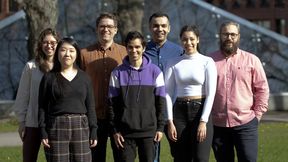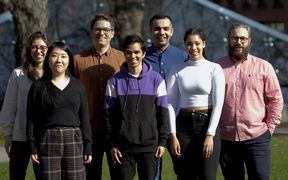Brighter together: designing sustainable technologies to create electronic devices

An article about an Aalto research project focusing on light-emitting electrochemical cells has been published in Chemical Science. The research was conducted by the Photoactive Organic Materials group in collaboration with a group in the Technical University in Munich. The research touches our everyday lives, as it’s closely related to electronic devices we all use in our day to day lives.
The research project has a significant importance, as doctoral researcher Alba Sanz Velasco explains when talking about the context of the study: “We are currently living in a digital era, surrounded by electronic devices such as smartphones, tablets, or TVs. However, materials used for developing this technology, in general, fall short of meeting environmental sustainability standards. For example, Organic Light Emitting Diodes (OLEDs) are broadly used to create light in display panels, but the short lifetimes of their materials significantly limit their long-term use. Therefore, in this research we have focused on improving the lifespan by designing a new technology based on light-emitting cells (LECs) in which light is created by a more sustainable material. Moreover, LECs comes with lower manufacturing costs compared to OLEDs. Our research results emphasize the potential of this technology as a promising and innovative substitute to current options.”
The weakness of current broadly used technology acted as a catalyst for the research. The researchers aimed to create a more sustainable way of fulfilling the needs of humankind. “Sustainability surrounding OLEDs for lighting applications concern not only from environmental factors but also disadvantages associated to their long-term applicability. The main drawback of this technology is the short lifespan of the material caused by an inner phenomenon. In essence, our research aimed at developing materials for lighting applications with the broader goal of creating sustainable technologies that balance human needs with environmental preservation”, Sanz Velasco further explains.
The article (“Controlling aggregation-induced emission by supramolecular interactions and colloidal stability in ionic emitters for light-emitting electrochemical cells”) can be read in Chemical Science.
Photoactive Organic Materials
Group led by Research Fellow Eduardo Anaya

- Published:
- Updated:
Read more news

In low-hierarchy organisations, even key policy issues are discussed in Slack
In a recent study, Aalto University alumn Lauri Pietinalho, a visiting scholar at New York University's Stern School of Business, and Frank Martela, an assistant professor at Aalto University, investigated how low-hierarchy organisations deal with shared policies in confrontational situations and how authority functions within them.
Getting bacteria into line
Physicists use magnetic fields to manipulate bacterial behaviour
Campus for people, plants and pollinators
The Otaniemi campus nature is managed with respect to biodiversity and the characteristic species of habitats.